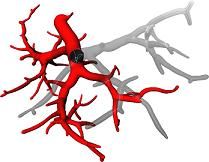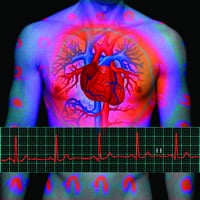VASCULAR
From the Latin vascularius , vascular is an adjective that is used in biology , zoology and botany to name what belongs to or is linked to vessels. A vessel is, in this sense, a channel that allows the circulation of blood or lymph in the body of a person or an animal, or sap or latex in the case of a plant.

Sometimes we speak of the vascular system to name the circulatory system , which is the structure of the anatomy that includes the cardiovascular system (which conducts blood) and the lymphatic system (dedicated to conducting lymph).
The vascular tension is that which appears on the walls of the ducts that allow the transport of blood. Said tension is produced by the pressure of the circulating liquid and by the elastic characteristics of the walls themselves.
The cerebrovascular accident (CVA) , also known as stroke, is a type of disease that is characterized by sudden blockage of blood flow to the brain. This fact can generate various symptoms, such as facial paralysis, lack of strength in a limb, problems with expression or vision disorders, among others.
The vascular dementia occurs when damage occurs in memory with impaired cognition such as aphasia (language problems), the agnosia (difficulty recognizing objects) or apraxia (disability movement). It is a syndrome of multifactorial etiopathogenesis syndrome, which indicates that the problems it can cause can be very diverse, but all are related to the deterioration of brain functions.
The vascular tissue , finally, is found in many plants, which are called vascular, and consists of a continuous system of fluids that move throughout the body to allow its subsistence and participate in the process of photosynthesis. This type of structure is made up of two well differentiated pathways: xylem (a tissue that carries H2O and mineral salts) and phloem (conducts nutrients that are developed by photosynthesis and cells).
Vascular diseases
 The arteries are blood vessels that carry blood, nutrients and oxygen from one place to another throughout the body. There is a disease known as arteriosclerosis that begins when the arteries harden and narrow, hindering the flow of the elements and complicating the normal functioning of the body. The consequences of this problem can be tissue damage, failure of functions and, taken to the extreme, the death of the patient.
The arteries are blood vessels that carry blood, nutrients and oxygen from one place to another throughout the body. There is a disease known as arteriosclerosis that begins when the arteries harden and narrow, hindering the flow of the elements and complicating the normal functioning of the body. The consequences of this problem can be tissue damage, failure of functions and, taken to the extreme, the death of the patient.
A vascular disease can present various symptoms, depending on the area of the body affected. Some of the most common forms are severe, pressing chest pain, angina in the chest, and obvious shortness of breath. In more advanced cases, the arteries can become clogged with blood clots called thrombosis . This generates acute pain in the patient and, if it is a severe complication, his life could be at risk.
The clogging of the arteries can cause various complications in the body, some of them may be:
* Cerebrovascular accident : also called a stroke or cerebrovascular accident , it consists of the partial or absolute loss of neuronal functions as a cause of poor blood supply to the brain.
* Aneurysm of aorta : originates in dilatation of the artery walls, usually related to degenerative complications or because of other conditions such as trauma, cystic necrosis or connective tissue disease .
Statistics show that 10% of deaths are caused by cerebral accidents and most of those affected are usually elderly; moreover, 80% of these accidents are due to an ischemic condition (thickening of the arteries) and the rest due to bleeding .
Comments
Post a Comment